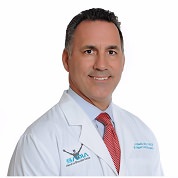Hand and Upper Limb Orthopedic surgeon Dr. Alejandro Badia offers tips to reduce upper-limb strains, sprains, pain.
MIAMI, Fla. (PRWEB) February 06, 2019
Sprains, strains, and pain may be merely a bike ride away unless a cyclist approaches the activity with the same preparation, care and correct equipment as required for any sport.
That’s the cautionary note from hand and upper limb orthopedic surgeon Alejandro Badia MD, who says cycling-related injuries to the upper extremities – hands, wrists, forearms, elbows shoulders, even the neck — are not limited simply to fractures caused by bike crashes or falls. Repetitive motion and overuse of muscles, ligaments and joints also play important injury roles, often resulting in numbness, tingling and pain, especially in fingers, hands, and wrists.
“The prolonged awkward position required during road biking, tight gripping of handlebars, hyperextended posture of wrists and constant use of hand-brakes and gear pedals can promote – or exacerbate – painful conditions. These can include tendinitis, an irritation of tendons connecting muscle to bone; carpal tunnel syndrome, caused by compression of the median nerve at the wrist; osteoarthritis at the base of the thumb; shoulder bursitis; and lateral epicondylitis (tennis elbow),” explains Dr. Badia, director of the Badia Hand to Shoulder Center and CEO and chief medical officer for OrthoNOW®, which has treated triathletes participating in the Ironman® competition in Miami.
As a specialist in care of upper limbs, Dr. Badia says most overuse injuries or aggravated muscle, tendon and joint problems can be managed conservatively. For example, correction of carpal tunnel syndrome requires only a “five-minute outpatient procedure, in which the surgeon releases the transverse carpal ligament,” he says. Tennis elbow can oftentimes be resolved with a painless, minimally invasive ultrasonic ablation procedure.
Ways to prevent overuse injuries include regularly changing one’s grip on the bike to alternate pressure on the palms of the hand, preventing wrists from dropping below the handlebars, and cycling with elbows bent rather than arms locked straight forward, he says.
Of course, simple positional adjustments will not protect the bike rider if a crash does occur. In fact, bicycle mishaps are the more common mechanism of injury among cyclists, Dr. Badia says.
Bike-related falls can lead to fractures of the clavicle (collarbone) when the rider flies over the handlebars, the elbow and, more frequently, the wrist, particularly the scaphoid bone and the distal radius or “spongy portion of bone” at the wrist-end of the forearm, says Dr. Badia.
Dr. Badia, along with his colleagues, have revolutionized treatment of distal radius fractures. The advanced approach involves use of a titanium plate and screws to affix the displaced bone in the correct anatomical position.
A compression screw usually suffices for treating scaphoid fractures. The screw “allows early motion of the wrist and minimizes risk of stiffness and atrophy due to prolonged casting,” Dr. Badia says.
Most upper-limb injuries can be effectively treated by an appropriate orthopedic specialist and the cyclist returned to the road again within a relatively short time period, Dr. Badia says. However, disconcerting to him and other experts is the increasing number of overall injuries related to the growing popularity of cycling.
In a presentation at the 2018 Annual Meeting of the American Academy of Orthopaedic Surgeons, researchers reported a 35 percent increase in bike-related cervical spine fractures, especially among men, in the United States between 2000 and 2015.
The “best medicine,” of course, is prevention. Dr. Badia says cyclists can minimize their injury risks while enjoying all the positive health benefits of their sport, including enhanced stamina, strength and cardiac function, simply by following a few tips:
- Adhere to rules of the road. Obey traffic signals and use recognized hand-arm gestures to indicate turns and stops. Never ride two or more abreast on the roadway.
- Favor roads that are marked with bike lanes to keep riders safe
- Equip bike with reflective materials and wear brightly-colored clothes to maximize visibility. Make sure clothes, shoes are comfortable and do not interfere with bike operation.
- Check the bicycle each week to keep it in proper condition. Have a bike serviced professionally at least annually.
- Avoid wearing headphones or other devices that divert attention from cycling.
- Ride with back straight and elbows bent; regularly adjust hand position and grip.
- Don’t over-cycle. Every mile pedaled forward requires a mile in return.
- “Above all, wear a helmet, because head, neck and facial trauma are the true dangers of cycling,” Dr. Badia says. “Head and facial injuries account for nearly 50 percent of cyclist visits to hospital emergency departments. Most such incidents could be prevented with a helmet.”
Bio: Alejandro Badia, MD, FACS, internationally renowned hand and upper-limb surgeon and founder of Badia Hand to Shoulder Center and OrthoNOW®, a walk-in orthopedic care clinic. He is a member the American Society for Surgery of the Hand, American Association for Hand Surgery and the American Academy of Orthopedic Surgeons. He is a specialist in treating all problems related to the hand and upper extremity including trauma, sports injury, joint reconstruction, nerve injuries and arthroscopic surgeries. http://www.drbadia.com

